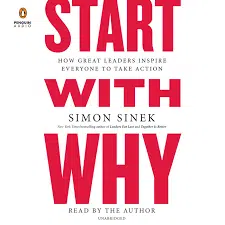“Start with Why” is a book written by Simon Sinek that explores the concept of how leaders and organizations can inspire others by starting with the “why” behind their actions, rather than simply focusing on the “what” or “how.” The book argues that great leaders and successful organizations have a clear sense of purpose, or “why,” and that this sense of purpose is the driving force behind their ability to inspire and motivate others. Sinek argues that by communicating the “why” behind their actions, leaders can create a sense of shared purpose and inspire others to take action. Through a series of case studies and examples, Sinek demonstrates how this approach has been used by successful leaders and organizations, and offers practical advice for anyone looking to inspire and motivate others.
The main points of the book are:
- The “Golden Circle” is a framework for understanding why some leaders and organizations are able to inspire and motivate others, while others struggle to do so.
- The Golden Circle consists of three elements: Why, How, and What.
- The Why is the purpose, cause, or belief that drives an organization. It’s the reason the organization exists.
- The How is the way in which the organization fulfils its Why. It’s the actions and behaviours that demonstrate the organization’s values and beliefs.
- The What is the product or service that the organization offers. It’s the tangible result of the organization’s Why and How.
- Most organizations start with What they do and then try to explain How and Why they do it. This is the wrong approach.
- The most successful organizations start with Why they do what they do and then communicate How and What they do in a way that resonates with their audience.
- When you start with Why, you tap into the emotional and primal part of the brain that motivates and inspires people to take action.
- The Why is the foundation of trust and loyalty. When people understand and believe in the Why of an organization, they are more likely to trust and support it.
- The Why is the reason people choose one organization over another, even if the products or services are similar.
- The Why is the reason people will advocate for an organization and its products or services, even if they don’t work for the organization.
- Leaders who start with Why are able to create a shared sense of purpose and direction within their organization, which leads to greater cohesiveness and commitment.
- The Why is not about making money. It’s about the purpose or belief that inspires an organization to do what it does.
- The Why should not change over time. It’s the foundation upon which an organization is built and should remain constant.
- The How and What should change and evolve over time, as the organization adapts to changing circumstances and customer needs.
- The Why should be communicated in a clear and concise manner, in a way that resonates with the audience.
- The Why should be communicated consistently, through words and actions, in order to build trust and loyalty.
- The Why should be communicated to all levels of the organization, in order to create a shared sense of purpose and direction.
- The Why should be communicated to customers and other stakeholders, in order to differentiate the organization from its competitors and build a loyal following.
- The Why should be communicated through storytelling, in order to engage and inspire people on an emotional level.
- The Why should be communicated through branding and marketing, in order to clearly communicate the organization’s purpose and values to the public.
- The Why should be communicated through leadership, in order to inspire and motivate others to take action.
- The Why should be communicated through corporate social responsibility initiatives, in order to demonstrate the organization’s values and commitment to making a positive impact on the world.
- The Why should be communicated through the organization’s culture, in order to create a cohesive and aligned organization.
- The Why should be communicated through the employee experience, in order to attract and retain top talent.
- The Why should be communicated through the customer experience, in order to create loyal customers.
- The Why should be communicated through the design and functionality of products or services, in order to create a cohesive and aligned organization.
- The Why should be communicated through innovation, in order to stay relevant and meet the changing needs of customers.
- In summary, starting with Why is a powerful way to inspire and motivate others, build trust and loyalty, and differentiate an organization from its competitors. By communicating the Why consistently, through words and actions, leaders and organizations can create a shared sense of purpose and direction, and inspire others to take action.
To buy the book click here


 Click here
Click here